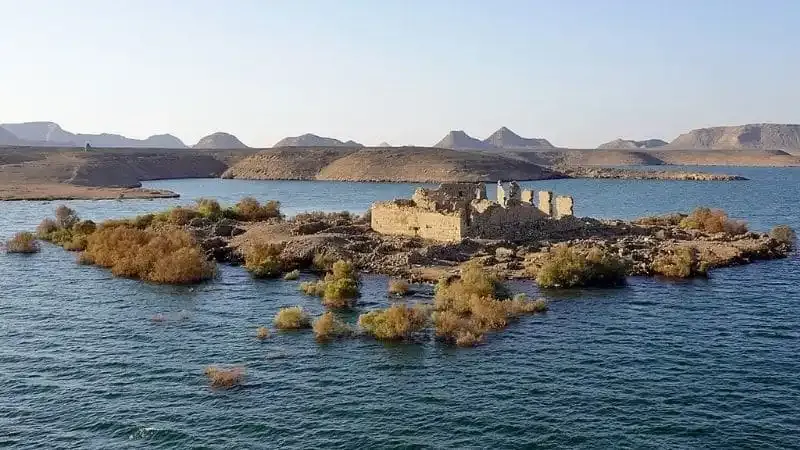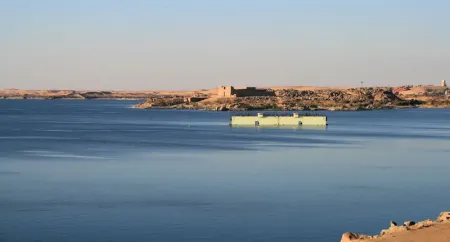qasr ibrim, Lake Nasser Ruins, Abu simbel

Qasr Ibrim, Lake Nasser Ruins, and Abu Simbel: The Timeless Guardians of Nubia
Hidden amid the sun-drenched expanse of southern Egypt, the region surrounding Qasr Ibrim, Lake Nasser, and Abu Simbel embodies the soul of ancient Nubia. Each site tells a tale of resilience, grandeur, and divine artistry. These monumental ruins not only reveal the ingenuity of ancient Egyptians but also the legacy of Nubian cultures that flourished for millennia along the Nile’s southern frontier. Standing proudly above the waters of Lake Nasser, these archaeological treasures symbolize survival — both against time and the encroaching waves created by the Aswan High Dam. To truly understand Egypt’s southern spirit, one must journey here, where temples defy submersion, and history clings to every stone.
Qasr Ibrim, the last remaining ancient site still in its original location along Lake Nasser, was once a fortress commanding the Nile’s vital trade routes. Abu Simbel, world-renowned for its colossal statues of Ramses II, remains a masterpiece of devotion and power. Between them, the vast Lake Nasser — itself a modern marvel — hides numerous ancient towns and temples, their remnants preserved beneath its shimmering surface. A visit to these sites isn’t just a step back into history; it’s a pilgrimage to the living memory of human endurance and creativity. Travelers seeking to go beyond the Egypt Travel Packages and explore the lesser-known wonders of Nubia will find themselves captivated by the stories etched in these monumental stones.
The Enigmatic Fortress of Qasr Ibrim: The Sentinel of Lake Nasser
Perched high upon a cliff overlooking Lake Nasser, Qasr Ibrim stands as a testament to centuries of military strength and religious devotion. Once an impregnable stronghold, it guarded Egypt’s southern frontier and served as a cultural crossroads between Egyptian and Nubian civilizations. Its origins trace back to Pharaonic times, though it gained prominence during the Meroitic and Christian Nubian periods. Archaeologists have unearthed layers of history here — from hieroglyphic inscriptions to Coptic manuscripts — revealing a site that adapted with each passing era.
Today, Qasr Ibrim is accessible only by special permission, as it remains protected and partially surrounded by Lake Nasser’s waters. What makes this site unique is that it wasn’t relocated during the building of the Aswan High Dam, unlike nearby temples. Instead, it sits proudly on its original rocky perch, offering visitors a rare glimpse into an untouched chapter of Nubian history. The fortress itself once held temples, churches, and fortifications — all testaments to the changing rulers who valued its strategic position. As one gazes across the tranquil expanse of the lake, it’s impossible not to feel the echo of ancient footsteps that once guarded this passage of empires.
Architectural Layers and Historical Significance
Qasr Ibrim’s architecture mirrors the evolving identity of the region. The remnants of Roman fortifications blend with early Christian churches and later Islamic influences, illustrating how the fortress adapted through dynasties. Archaeological finds include pottery, manuscripts, and coins that trace the ebb and flow of civilizations. Scholars often describe it as a living archive of Nubian transition — a microcosm of Egypt’s southern history. Nearby, travelers cruising along Egypt Nile Cruises can marvel at the fortress from the deck, its silhouette framed against the golden desert horizon.
Lake Nasser Ruins: The Submerged Legacy of Ancient Nubia
When the Aswan High Dam was completed in the 1960s, the creation of Lake Nasser submerged entire Nubian villages and countless archaeological sites. Yet, amid this monumental transformation, UNESCO launched one of the most ambitious archaeological rescue missions in history. Temples like Abu Simbel and Philae were painstakingly relocated, stone by stone, to higher ground. Beneath Lake Nasser’s turquoise waters now rest the echoes of temples, fortresses, and settlements — an underwater museum that speaks to humanity's determination to preserve its past.
Stretching over 500 kilometers, Lake Nasser is not only the largest man-made lake in Africa but also a haven for explorers and historians. Modern travelers can trace the route of the ancient Nile journey by embarking on luxurious cruises across the lake, visiting monumental sites along its shores. A journey here complements adventures through Egypt Excursions, offering a tranquil yet powerful immersion into Egypt’s Nubian heritage.
Temples Rescued from the Waters
The most iconic of the rescued temples include Amada, Wadi es-Sebua, and Dakka, each reassembled with remarkable precision. The Temple of Amada, devoted to Amun and Ra-Horakhty, stands as the oldest of the relocated monuments, its colorful reliefs still vivid after thousands of years. Wadi es-Sebua, built by Ramses II, reveals colossal sphinx-lined avenues symbolizing power and divine authority. These temples, along with Beit el-Wali and Kalabsha, continue to narrate the story of Egypt’s southern frontier — a land both sacred and strategic.
Ecological and Cultural Impact of Lake Nasser
Beyond archaeology, Lake Nasser has transformed the local ecosystem and economy. Its creation fostered a new era of fishing, tourism, and environmental conservation. The lake’s tranquil waters reflect an unexpected harmony between ancient ruins and modern progress. For travelers, the journey across Lake Nasser is not merely scenic; it’s an experience that blends history with nature, serenity with adventure. Those who explore the region often combine their visit with tours of Egypt Vacations Packages that include Aswan and Nubia, ensuring a deep dive into the historical heart of southern Egypt.
Abu Simbel: The Monument of Eternal Glory
No journey through Nubia is complete without witnessing the awe-inspiring grandeur of Abu Simbel. Carved directly into the cliffs by Pharaoh Ramses II during the 13th century BCE, this temple complex was designed to display his divine power and eternal devotion to the gods — and, of course, to his beloved Queen Nefertari. The temple’s facade, adorned with four colossal seated statues of Ramses II, each over 20 meters tall, dominates the desert landscape. Inside, intricately carved chambers depict scenes of gods, battles, and rituals that celebrate the pharaoh’s might and divinity.
The Abu Simbel temples were famously relocated during the construction of the Aswan High Dam. This engineering feat remains one of UNESCO’s proudest achievements, saving the temples from submersion by cutting them into massive blocks and reassembling them on an artificial hill above Lake Nasser. Today, this site stands not only as a testament to ancient artistry but also as a triumph of modern preservation. Travelers visiting the Abu Simbel temples often describe the experience as spiritual, standing face-to-face with history’s monumental ambition.
The Solar Alignment Phenomenon
One of Abu Simbel’s most astonishing features is its solar alignment. Twice a year, on February 22 and October 22, sunlight pierces through the temple’s inner sanctuary, illuminating the statues of Ramses II and the gods Amun-Ra and Ra-Horakhty — but leaving Ptah, the god of darkness, in shadow. These events mark Ramses II’s coronation and birthday, a cosmic celebration of divine kingship that continues to draw thousands of visitors annually. Observing this alignment at dawn, with the golden light dancing across the statues, is an unforgettable moment — a perfect fusion of science, art, and spirituality.
The Temple of Queen Nefertari
Adjacent to the main temple stands a smaller yet equally magnificent one dedicated to Queen Nefertari, whom Ramses II deified as the goddess Hathor. The temple’s beautifully preserved reliefs depict the queen alongside the goddess, emphasizing her divine status. The artistry here is delicate and intimate, contrasting the monumental masculinity of the main temple. Visitors often linger in awe, realizing that Abu Simbel is not merely a monument of power but also one of love and reverence.
Travel Tips for Visiting Abu Simbel and Lake Nasser
For those planning to explore Abu Simbel and nearby attractions, early morning visits are ideal to capture the temples in soft light and avoid the midday heat. Many travelers choose to combine the trip with a Lake Nasser cruise departing from Aswan City, ensuring a seamless journey through Nubia’s majestic landscapes. These tours offer a chance to witness the untouched beauty of southern Egypt, far from the crowded corridors of mainstream attractions like the Great Pyramids of Giza.
Preservation and Cultural Unity
Abu Simbel’s relocation not only preserved its physical structure but also united nations in a global effort to safeguard humanity’s shared heritage. The project involved engineers, archaeologists, and historians from across the world, proving that cultural preservation transcends borders. Today, the temples continue to inspire new generations of travelers, scholars, and artists, reminding everyone that legacy is both fragile and eternal.
FAQs about Qasr Ibrim, Lake Nasser Ruins, and Abu Simbel
1. Where is Qasr Ibrim located, and why is it significant?
Qasr Ibrim lies on the eastern bank of Lake Nasser in southern Egypt, about 70 kilometers north of Abu Simbel. It’s historically significant as the only ancient Nubian site still in its original location, preserving layers of Egyptian, Roman, Christian, and Islamic heritage. The fortress served as a military and religious center controlling trade routes and defending Egypt’s southern frontier.
2. Can visitors access Qasr Ibrim today?
Due to its archaeological importance and preservation efforts, access to Qasr Ibrim is restricted. Visitors can view the site from Lake Nasser cruise boats or aerial tours. This exclusivity enhances its mystique, making it one of the most fascinating yet least disturbed ancient sites in Egypt.
3. What makes Abu Simbel unique compared to other Egyptian temples?
Abu Simbel stands out for its colossal rock-cut design, symbolic solar alignment, and the extraordinary relocation project that saved it from Lake Nasser’s rising waters. The temple embodies both artistic genius and engineering mastery, representing Ramses II’s divine power and Egypt’s architectural brilliance.
4. How were the Lake Nasser temples relocated?
During the 1960s, UNESCO coordinated a massive international effort to dismantle and reassemble several temples on higher ground. The process involved cutting the temples into blocks, each weighing up to 30 tons, and reconstructing them precisely as they stood. This feat remains one of the most successful preservation campaigns in history.
5. What’s the best way to explore Lake Nasser and its ruins?
The most rewarding way to experience Lake Nasser’s archaeological wonders is by joining a Best Nile River Cruises itinerary that includes destinations from Aswan to Abu Simbel. These journeys blend luxury with discovery, offering unparalleled access to remote temples, Nubian landscapes, and serene waters that hide untold stories of ancient civilizations.


